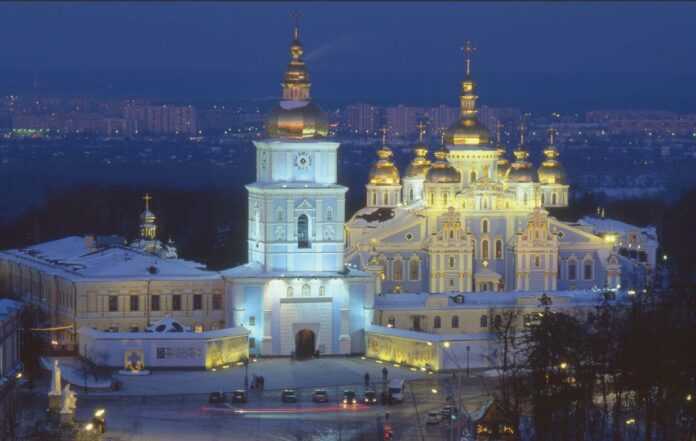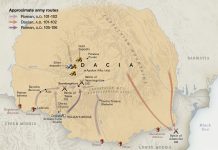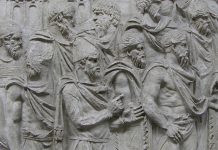St. Michael’s Golden-Domed Monastery is situated on the central hill of Kyiv overlooking the Dnieper River and the northern part of Ukraine’s capital. Sviatopolk II of Kyiv was the one who founded a stone church as a central part of the complex around 1100 AD. Stressing that “there were once many medieval churches in Kyiv, but nearly all of them were timber-built; none of these have survived”, the Wikipedia article fails to mention two stone churches in Kyiv that predated the St. Michael’s Monastery: Church of the Tithes, and Saint Sophia Cathedral. Also, Kyiv Pechersk Lavra‘s first stone cathedral is most likely older than the St. Michael’s church.
The Austrian soldier and diplomat Erich Lassota visited Kyiv in 1594. He wrote a diary of his travels, later published as Tagebuch des Erich Lassota von Steblau, and described the monastery:
“It is a fine building. In the center, it has a round cupola with a golden roof. The choirs are turned inwards and are also decorated with mosaics. The floor is laid out with small, colored stones. As one enters the church through the gates which are directly opposite the high altar, one sees on the left a wooden casket that holds the body of a saintly virgin, Barbara, a king’s daughter: she was a young girl, about 12 years old, as can be judged by her size. Her remains, covered down to her feet with a piece of fine linen, have not decomposed yet as I myself could observe by touching her feet which were still hard and not deteriorated. On her head, there is a gilded crown made of wood.” (The Habsburgs and Zaporozhian Cossacks (1594).
The Syrian traveler and writer Paul of Aleppo visited the Monastery during the summer of 1654. In describing the church, he compared it with St. Sophia in Kyiv and the Hagia Sophia in Constantinople, writing of St. Michael’s:
“The entire building is of wood, except the magnificent, lofty, and elegant church, which is of stone and lime, and has a high cupola shining with gold. This church consists only of one nave. It is lighted all round with glazed windows. The three churches I have been describing are all of one style of architecture, and of one age. As to the throne of the Chief of the Clergy, it is very magnificent and beautiful; and in the front of it, on the left, is the portrait of Theophani, Patriarch of Jerusalem, in his cap and cassock, and holding a cross. The large Tabernacle resembles that of St. Sophia, and of the Convent of Petcherske [Kyiv Pechersk Lavra], and has three large windows; and, in like manner, it is painted in the centre with the portrait of Our Lady, standing upright in her gold ornaments, and having both her hands raised and open. Next to her is Our Lord, handing to his Disciples, on both sides, the divine bread and blood. Below them are the portraits of Chief Priests, in rows, and all with inscriptions. On the right of this tabernacle is a second, with a lofty cupola: and on the left is a third. This holy church has also three doors: the largest is to the west; the other two give admission to the two choirs. At the back of the left choir is a handsome tabernacle, facing your left-hand as you enter. It has an iron folding-door reaching from the top to the bottom, and beautifully divided into compartments,, which are diversified with painted flowers and the figures of angels and saints, in the manner we described of St. Sophia. Within it is a handsome sarcophagus, containing the body of St. Barbara of Baalbec. So also on the right, as you enter the church, is another tabernacle in the western wing: and without the angle is a sixth. The floor of the church is all of large red tile. Near to this convent, and indeed contiguous, is one of Nuns. I should have mentioned, that the image of St. Michael is very magnificent and venerable; all its armour, its breast-plate, bracelets, visor and helmet, being of pure silver, coloured, and with the bosses gilt; the work of an ingenious master.”” (The Travels of Macarius: Patriarch of Antioch)
Importance of St. Sophia in Kyiv >
The “Kyiv Rus in Heimskringla Sagas and Byzantine Texts” book has little-known facts about the construction of St. Sophia Cathedral and of Pechersk Lavra’s first stone building (spoiler: a Viking in exile has a direct relation to it).










